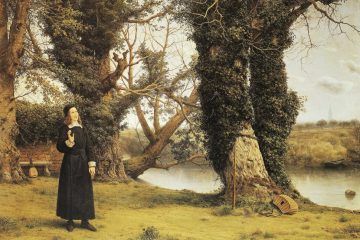Hannah Brooks-Motl at Poetry Magazine:
 Published shortly after his death in 1633, George Herbert’s The Temple is an example of a kind of poetry-project, the exact meaning of which has been debated almost since its first appearance. Because it is composed of poems with titles like “The Altar” and “The Windows,” some critics have believed Herbert was attempting to recreate the elements of a church in the structure of his book; others thought he was mapping the liturgical year through poems such as “Whitsunday,” “Lent,” and “Christmas.” Some, such as Helen Vendler, note that the book models new kinds of friendship and lyric address, even anticipating, in Herbert’s painstaking dissections of his own weakness and his many dialogues with God, “the modern notion of the ideal therapist.” Still others, notably Stanley Fish, think about The Temple’s project in the terms Herbert himself set out, in a chapter on catechizing in his prose work The Life of a Country Parson: “at Sermons, and Prayers, men may sleep or wander;” Herbert wrote, “but when one is asked a question, he must discover what he is.” Herbert’s project, in this reading, is a kind of “catechism” intent on leading the reader to discover “what he is” for himself. “What is crucial,” Fish notes, “is not the dialogue in the poem, but the dialogue the poem is in.” Herbert wasn’t just writing about his own relationship with God, he was writing to alter his readers’ sense of their own. But despite, or because of, such varying interpretations, what has never been disputed is the “project-ness” of The Temple: “We cannot judge Herbert, or savour fully his genius and his art, by any selection to be found in an anthology,” T.S. Eliot wrote in his seminal study of the poet. “We must study The Temple as a whole.”
Published shortly after his death in 1633, George Herbert’s The Temple is an example of a kind of poetry-project, the exact meaning of which has been debated almost since its first appearance. Because it is composed of poems with titles like “The Altar” and “The Windows,” some critics have believed Herbert was attempting to recreate the elements of a church in the structure of his book; others thought he was mapping the liturgical year through poems such as “Whitsunday,” “Lent,” and “Christmas.” Some, such as Helen Vendler, note that the book models new kinds of friendship and lyric address, even anticipating, in Herbert’s painstaking dissections of his own weakness and his many dialogues with God, “the modern notion of the ideal therapist.” Still others, notably Stanley Fish, think about The Temple’s project in the terms Herbert himself set out, in a chapter on catechizing in his prose work The Life of a Country Parson: “at Sermons, and Prayers, men may sleep or wander;” Herbert wrote, “but when one is asked a question, he must discover what he is.” Herbert’s project, in this reading, is a kind of “catechism” intent on leading the reader to discover “what he is” for himself. “What is crucial,” Fish notes, “is not the dialogue in the poem, but the dialogue the poem is in.” Herbert wasn’t just writing about his own relationship with God, he was writing to alter his readers’ sense of their own. But despite, or because of, such varying interpretations, what has never been disputed is the “project-ness” of The Temple: “We cannot judge Herbert, or savour fully his genius and his art, by any selection to be found in an anthology,” T.S. Eliot wrote in his seminal study of the poet. “We must study The Temple as a whole.”
more here.
